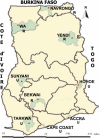High frequency of the Duffy-negative genotype and absence of Plasmodium vivax infections in Ghana
- PMID: 33596926
- PMCID: PMC7888148
- DOI: 10.1186/s12936-021-03618-0
High frequency of the Duffy-negative genotype and absence of Plasmodium vivax infections in Ghana
Abstract
Background: Recent studies from different malaria-endemic regions including western Africa have now shown that Plasmodium vivax can infect red blood cells (RBCs) and cause clinical disease in Duffy-negative people, though the Duffy-negative phenotype was thought to confer complete refractoriness against blood invasion with P. vivax. The actual prevalence of P. vivax in local populations in Ghana is unknown and little information is available about the distribution of Duffy genotypes. The aim of this study was to assess the prevalence of P. vivax in both asymptomatic and symptomatic outpatients and the distribution of Duffy genotypes in Ghana.
Methods: DNA was extracted from dried blood spots (DBS) collected from 952 subjects (845 malaria patients and 107 asymptomatic persons) from nine locations in Ghana. Plasmodium species identification was carried out by nested polymerase chain reaction (PCR) amplification of the small-subunit (SSU) rRNA genes. For P. vivax detection, a second PCR of the central region of the Pvcsp gene was carried out. Duffy blood group genotyping was performed by allele-specific PCR to detect the presence of the FYES allele.
Results: No cases of P. vivax were detected in any of the samples by both PCR methods used. Majority of infections (542, 94.8%) in the malaria patient samples were due to P. falciparum with only 1 infection (0.0017%) due to Plasmodium malariae, and 2 infections (0.0034%) due to Plasmodium ovale. No case of mixed infection was identified. Of the samples tested for the FYES allele from all the sites, 90.5% (862/952) had the FYES allele. All positive samples were genotyped as FY*B-33/FY*B-33 (Duffy-negative homozygous) and therefore classified as Fy(a-b-).
Conclusions: No cases of P. vivax were detected by both PCRs and majority of the subjects tested carried the FYES allele. The lack of P. vivax infections observed can be attributed to the high frequency of the FYES allele that silences erythroid expression of the Duffy. These results provide insights on the host susceptibility for P. vivax infections that had not been investigated in Ghana before.
Keywords: Duffy blood group; Duffy-negative; Ghana; Malaria; Plasmodium vivax.
Conflict of interest statement
The authors declare that they have no competing interests.
Figures


References
-
- WHO . World malaria report 2019. Geneva: World Health Organization; 2019.
-
- WHO . World malaria report, 2016. Geneva: World Health Organization; 2016.
-
- Mueller I, Galinski MR, Baird JK, Carlton JM, Kochar DK, Alonso PL, et al. Key gaps in the knowledge of Plasmodium vivax, a neglected human malaria parasite. Lancet Infect Dis. 2009;9:555–566. - PubMed
MeSH terms
Substances
Grants and funding
LinkOut - more resources
Full Text Sources
Other Literature Sources

